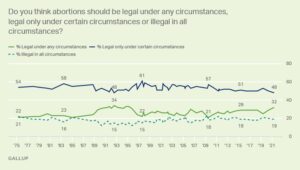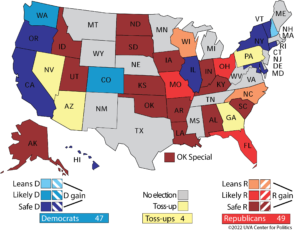In “The voter turnout gap may be even bigger than we think” at CNN Politics, Ronald Brownstein writes that, according to a new study, “while people of color will continue their steady growth to become nearly 2 in every 5 eligible voters by 2030, the gap in voter turnout between minorities and Whites, as well as between younger and older generations, is even wider than commonly understood.” In addition,
“The data say we have a big problem, bigger than we thought,” says Tom Lopach, president and CEO of the Voter Participation Center and the Center for Voter Information, the two liberal-leaning non-profit groups that released the report last week. The groups focus on increasing participation among what they call the “New American Majority” – unmarried women, voters younger than 35 and people of color, all constituencies that mostly vote Democratic (even though Republicans have made recent gains among some of them).
The study’s conclusions could inflame the already smoldering debate among Democrats over where the party should place its greatest electoral emphasis. While the study’s sponsors say it shows the need for greater efforts to energize younger and non-White adults now voting at lower rates, it could also encourage the rising chorus of centrist party voices who say Democrats must emphasize positions more popular with moderate and even right-leaning adults who are more reliable voters. That pool of potential supporters includes some Hispanics but is centered on the non-college-educated White voters whose generation-long shift toward the GOP became a stampede in the Donald Trump era.
The study also points to a more civic, less partisan, challenge: a widening gap between an increasingly diverse population, especially among younger generations, and electoral results disproportionately shaped by the preferences of White voters, particularly older White voters. That could be a formula for growing social tension, political polarization and doubts about the legitimacy of governmental decisions.
Brownstein adds that “The study places turnout among Black and Latino voters at a much lower level not only than the official Census Bureau numbers, which many experts think are inflated, but also than the estimates by Catalist, a leading Democratic voter-targeting firm.” Further,
The report projects that people of color will grow from 28% of eligible voters in 2010 and 34% in 2020 to just over 38% by 2030. Adding in all the groups the organization defines as the “New American Majority” – all people of color, White unmarried women and White voters under 35 – raises the total from 57% of eligible voters in 2010 to 63% in 2030….By 2030, it estimates, these groups will compose at least two-thirds or more of the eligible population in three Sun Belt states that now lean at least slightly toward Republicans: Florida, Georgia and Texas. The report ranks Florida and Texas, as well as Arizona, another Sun Belt battleground that still leans slightly Republican, among the states where the three groups will increase their share of the population fastest.
Looking at turnout rates, Brownstein continues, “The Census Bureau, for instance, estimated that the share of Whites who turned out in 2020 (just over 70%) was about 9 percentage points higher than the share of African Americans (61%) and about 18 points higher than the share of Latinos (52%). Catalist, the Democratic targeting firm, put the gaps somewhat wider, at 11 points between Whites and Blacks and 24 points between Whites and Latinos.” Worse, for Dems,
But the new study found a much more forbidding chasm. For 2020 it placed the White turnout gap at 25 points with Blacks and at nearly 35 points with Latinos. (The report concludes that only a little over half of eligible Blacks and two-fifths of Latinos voted.) What’s more, the study concluded that the turnout gap between Whites and all voters of color was at least 14 points in every state and even higher in many states where Democrats and progressive groups have spent heavily on grassroots organizing and/or voter turnout efforts – including Arizona, Georgia, Michigan, Nevada and Pennsylvania – than in states where neither side invests much money, including Alabama and South Carolina. In the 2016 election, the new study likewise concludes, turnout among Blacks and Hispanics was much lower than either the Census Bureau or Catalist had found, while White turnout was slightly higher than either had estimated.
Looking back over the past three presidential elections, the report concluded the turnout gap between Whites and all non-Whites has actually expanded – more than doubling, in fact, over that period. The reason is that even though the share of all minorities casting ballots slightly increased from 2012 to 2020, White turnout has increased much more, according to the study’s estimates.
Brownstein notes, “many of the Sun Belt states where the demographic change is advancing most quickly are also among those where the Republicans now holding statewide power are erecting the most obstacles to voting, including Arizona, Florida, Georgia and Texas.”
“For all these reasons,” Brownstein explains, “while the groups sponsoring the study believe its findings argue for increased efforts to turn out younger and non-White voters, the results could also encourage the Democratic operatives and analysts who are arguing the party can’t rely on such mobilization. Since 2020 that loose circle – which includes Democratic voices such as David Shor, Ruy Teixeira, Bill Galston and Elaine Kamarck – has argued that the party must instead focus on winning back more working-class voters, especially Whites but also increasingly Latinos, by moving toward the center, particularly on cultural issues such as crime and immigration.”
All of the available data indicate that Democrats can’t afford much more leakage by any constituency in our evenly polarized electorate. There are trade-offs to be navigated with every policy choice, and the challenge for Dems is to hold on as much as possible to their supporters while targeting swing sub-groups with precision campaigning. Check out Andrew Levison’s recent strategy report on how Dems can win “culturally traditional but non-extremist working class voters” for one such approach.






